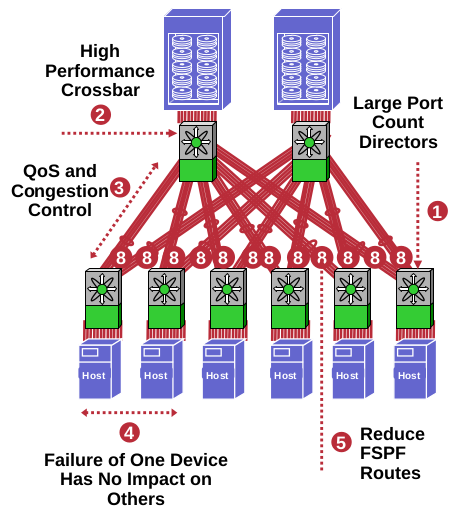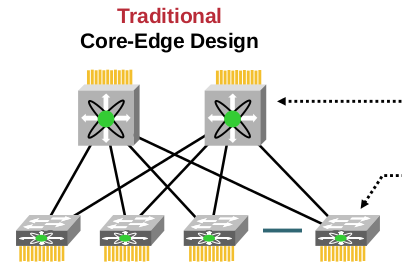- Cisco Community
- Technology and Support
- Data Center and Cloud
- Storage Networking
- Re: SAN design : core edge and dual-homing access switch
- Subscribe to RSS Feed
- Mark Topic as New
- Mark Topic as Read
- Float this Topic for Current User
- Bookmark
- Subscribe
- Mute
- Printer Friendly Page
- Mark as New
- Bookmark
- Subscribe
- Mute
- Subscribe to RSS Feed
- Permalink
- Report Inappropriate Content
10-22-2012 11:08 AM
Hello all.
It may sound as a dumb question (from a LAN guy) but when designing a core/edge or edge/ecore/edge design, why do we connect access switches to both core switches ? Doesn't it break the isolation of a dual fabric backbone ?
If an access switch fails the fault (bug or anything else) will propagate to both core switches ? Am I wrong ?
Example :
or from netrworkers sessions in 2006


Solved! Go to Solution.
- Labels:
-
Storage Networking
Accepted Solutions
- Mark as New
- Bookmark
- Subscribe
- Mute
- Subscribe to RSS Feed
- Permalink
- Report Inappropriate Content
10-23-2012 06:58 AM
Answer also from LAN guy,
Most likely this design diagram is due to assumption that there is no use of VSANs and SAN Multipathing drivers in host.
Following is excerpt from same like yo posted.
"SAN designs should always use two isolated fabrics for high availability, with both hosts and storage connecting to both fabrics. Multipathing software should be deployed on the hosts to manage connectivity between the host and storage so that I/O uses both paths, and there is non-disruptive failover between fabrics in the event of a problem in one fabric. Fabric isolation can be achieved using either VSANs, or dual physical switches. Both provide separation of fabric services, although it could be argued that multiple physical fabrics provide increased physical protection (e.g. protection against a sprinkler head failing above a switch) and protection against equipment failure. "
- Mark as New
- Bookmark
- Subscribe
- Mute
- Subscribe to RSS Feed
- Permalink
- Report Inappropriate Content
10-23-2012 06:58 AM
Answer also from LAN guy,
Most likely this design diagram is due to assumption that there is no use of VSANs and SAN Multipathing drivers in host.
Following is excerpt from same like yo posted.
"SAN designs should always use two isolated fabrics for high availability, with both hosts and storage connecting to both fabrics. Multipathing software should be deployed on the hosts to manage connectivity between the host and storage so that I/O uses both paths, and there is non-disruptive failover between fabrics in the event of a problem in one fabric. Fabric isolation can be achieved using either VSANs, or dual physical switches. Both provide separation of fabric services, although it could be argued that multiple physical fabrics provide increased physical protection (e.g. protection against a sprinkler head failing above a switch) and protection against equipment failure. "
- Mark as New
- Bookmark
- Subscribe
- Mute
- Subscribe to RSS Feed
- Permalink
- Report Inappropriate Content
10-23-2012 12:01 PM
ok; so in the case of using standard dualport HBA (or CNA) the pictures above represent only one fabric:)
thank you !
Discover and save your favorite ideas. Come back to expert answers, step-by-step guides, recent topics, and more.
New here? Get started with these tips. How to use Community New member guide
